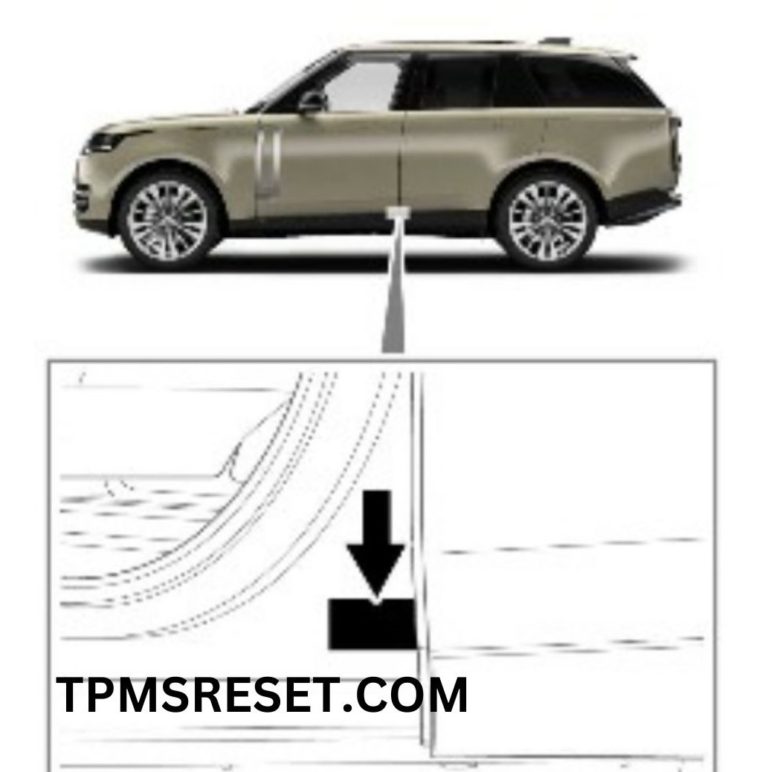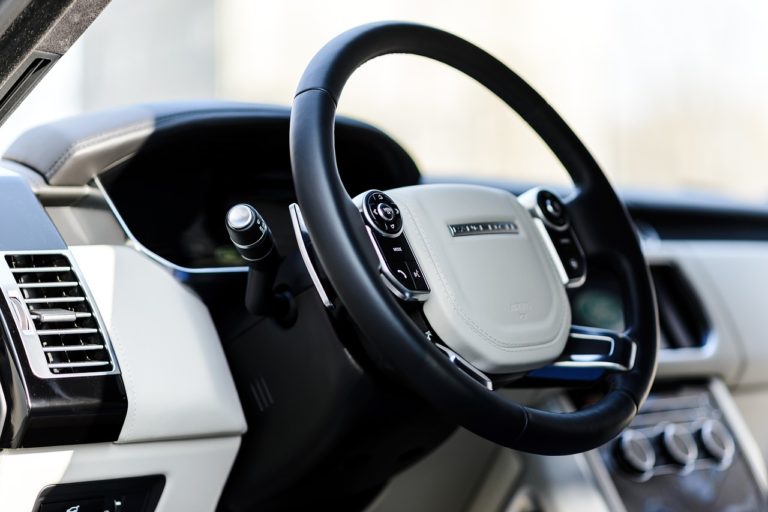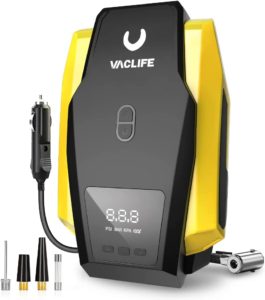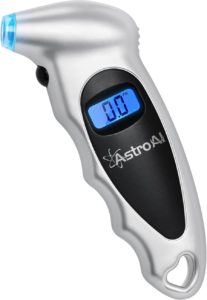Steps to Reset Range Rover TPMS
Step 1: Check and Adjust Tire Pressure
Range Rover and Range Rover sport do not have a tire pressure reset button like you might hope. Instead all you have to do is set your tire pressure to the exact pressure that Range Rover recommends. Follow the sequence below to find out what your current tire pressure is and what it’s supposed to be. Make sure you check your tire pressures when your tires are cold. This means before driving a long distance or after the car has been sitting for a few hours.
Turn the ignition on
Press the menu button on the steering wheel
Scroll down and select service menu
Select tire pressure check
This will show you the current pressure in your tires and the recommended tire pressure in parenthesis. You can also find your recommended pressure on the sticker on the driver-side door jamb.
Step 2: Drive the Car
After adjusting your tire pressures to the cold recommended pressure, drive your Range Rover. Drive at speeds of at least 15 Mph for at least a few minutes. If the tire light doesn’t go out right away, keep driving.
Step 3: Re-Check Tire Pressure
If the tire pressure light doesn’t go off after step 1 and step 2, recheck your tire pressure. Confirm that the pressure is still at the exact pressure you set it to. If it’s not, you likely have a tire leak or some sort of puncture. If the tire light goes off and then comes back on, you definitely have a tire leak. If the light flashes and then stays on, you have a TPMS malfunction. Read the section on TPMS Malfunction to learn more.
Other Range Rover Features To Know
To Change Pressure Monitoring Units
Select menu
Select service menu
Select tire pressure monitor
Select pressure display units
Choose between Psi, Bar, and kPa
To Change Pressure Load Settings
Select menu
Select service menu
Select tire pressure monitor
Select TPM load setting
Select Heavy load or Light load.
If you are just driving your Range Rover normally, select Light load. Heavy load is for towing or increasing the vehicle weight substantially.
All the steps above are applicable to all Range Rover trims and models from 2012-2024 including: Range Rover and Range Rover Sport. Includes 3.0 supercharged, 3.0 turbocharged, 5.0 liter, 3.0L V6 turbodiesel, 4.4L V6 turbodiesel.
2023 Range Rover Tire Pressures
Trim Model | Tire Size | Inflation PSI Front/Rear |
Range Rover Sport | 255/60R20 | 37 PSI/37 PSI |
Range Rover Sport | 275/55R20 | 37 PSI/37 PSI |
Range Rover Sport | 275/50R21 | 37 PSI/37 PSI |
Range Rover Sport | 285/45R22 | 37 PSI/37 PSI |
Range Rover Sport | SPARE TIRE | 60 PSI |
Range Rover TPMS Malfunction Indicator
Your Range Rover comes with a TPMS malfunction indicator that alerts you when the system isn’t working properly. This indicator uses the same dashboard light as the low tire pressure alert, but it has a different function. If the TPMS experiences an issue, the warning light will flash for around 75 seconds before staying lit continuously. This pattern will repeat every time you start the car until the problem is fixed. When the malfunction indicator is on, the system is not working correctly. (Basically, your tire pressure monitoring system won’t work correctly until the problem with the TPMS is resolved) Various factors, such as incompatible tires or wheels or a faulty tire pressure sensor will trigger TPMS issues. In other words, if you have a blinking tire pressure light, you have a problem with the TPMS system itself, not an air pressure problem. To determine which tire sensor is the problem, you will need a TPMS diagnostic tool like this Autel TPMS tool.
When Should you Reset your TPMS?
After replacing a TPMS sensor
After changing or rotating tires
After installing new wheels or tires
After experiencing a flat tire and repairing or replacing it
After changing the tire pressure to meet seasonal or load requirements
After receiving a TPMS warning/alert on the dashboard
After a significant temperature change that could affect tire pressure
After having a tire puncture repaired or patched
If the TPMS system is not properly functioning or providing accurate readings
As part of your regular vehicle maintenance schedule
How Range Rover TPMS Works
Sensors: Each tire on the Range Rover is equipped with a TPMS (Tire Pressure Monitoring System) sensor that constantly monitors the air pressure inside the tire.
Data transmission: The sensors transmit the tire pressure information wirelessly to the vehicle’s onboard computer or TPMS control module.
Monitoring: The TPMS control module continuously monitors the data received from all the sensors, keeping track of each tire’s pressure.
Comparison to optimal pressure: The system compares the measured tire pressure to the optimal or recommended pressure levels, which are set by Range Rover based on the vehicle’s specifications.
Alerts and warnings: If the tire pressure in any of the tires falls below a specified threshold (usually around 10% – 25% below the recommended pressure), the TPMS control module sends a signal to the instrument cluster to display a warning light or message to the driver.
Identification of affected tire: In your Range Rover, the system will provide information on which tire has low pressure, enabling you to address the issue promptly.
Ongoing monitoring: Once the system has been reset, it will continue to monitor the tire pressures and alert the driver if any further issues arise.
What Causes the TPMS Light to Turn On?
Low tire pressure: A tire’s pressure has dropped below the specified threshold.
Rapid pressure loss: A tire experiences a sudden loss of pressure, such as from a puncture or blowout.
Sensor malfunction: A TPMS sensor is not functioning correctly, providing inaccurate or inconsistent readings.
Battery issue: A TPMS sensor’s battery is depleted or dying, affecting its ability to transmit data. This will cause a TPMS malfunction as explained above.
System interference: External factors, such as electronic interference or physical damage, disrupt the communication between TPMS sensors and the control module.
Temperature changes: Significant temperature fluctuations can cause tire pressure to change, potentially triggering the TPMS warning. See below for more information on this.
Faulty control module: The TPMS control module itself is malfunctioning, which may cause it to display a warning or fail to detect a tire pressure issue.
How the Weather Affects your Tire Pressure
The line chart above shows how changes in outside temperature affect tire pressure, using both Fahrenheit and Celsius scales, as well as PSI and kPa units. As the temperature goes down, tire pressure tends to decrease, while it increases when the temperature goes up. The ideal temperature to check tire pressure is around 62°F (16.7°C), where tire pressure remains relatively stable. In simple terms, for every 10-degree drop in air temperature, tire pressure will decrease by approximately 1 PSI.
The Benefits of Range Rover's TPMS
Range Rover’s Tire Pressure Monitoring System (TPMS) offers numerous advantages to drivers, enhancing both safety and efficiency on the road. This technology keeps a constant eye on your tire pressure, ensuring optimal performance and a smooth driving experience. By alerting the driver to any significant changes in tire pressure, the TPMS promotes better fuel efficiency, reduced tire wear, and improved handling.
Moreover, the system helps prevent dangerous situations that can arise from underinflated or overinflated tires, such as blowouts, loss of control, and uneven tread wear. By maintaining proper tire pressure, Range Rover owners can also minimize their environmental impact, as properly inflated tires contribute to lower fuel consumption meaning reduced CO2 emissions.
Please note that this blog post contains Amazon affiliate links. This means that if you make a purchase through one of these links, we at TPMSRESET.com may earn a small commission at no extra cost to you. We only recommend products that they personally use and believe in. Thank you for supporting this blog.






